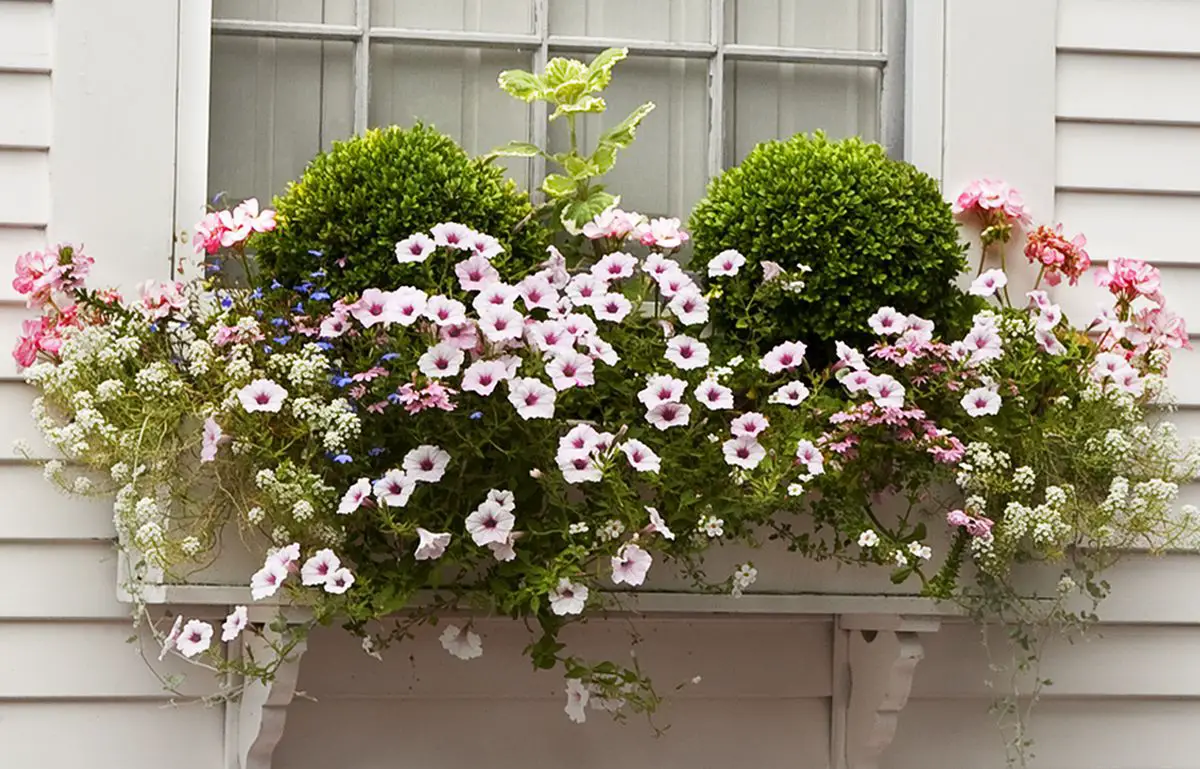Selecting the right plants for your window boxes and outdoor planters is an important step toward creating a beautiful and functional exterior. That’s because your choice can either uplift or downgrade your home’s curb appeal since each option has its own proper setting.
Here are some factors to consider when shopping for the right plants:
Color and Texture
Choose plants that complement each other in color and texture to create a visually interesting and uniform display.
Examples of plants suitable for window boxes:
- Ivy, ferns, and training succulents are good options for creating a hanging or cascading effect.
- Pansies, petunias, marigolds, geraniums, and Impatiens add color and character to the boxes.
- Ferns, coleus, and polka dot plants add interest with their foliage.
- Herbs like basil, thyme, and parsley improve your home’s air quality and can be used for cooking.
Light Requirements
Ensure you choose plants that will thrive in the amount of light available in the location of your flower window boxes. For instance, succulents and cacti can tolerate sunlight, while ferns and impatiens do well in the shade.
Climate
Before buying plants, check whether they’re well-suited for the climate in your area. Similarly, consider the amount of rainfall, sunlight, and wind exposure in your location to get an idea of the plants that will succeed in such conditions. Some crops can only
survive in warmer climates, while others tolerate colder temperatures.
Water Requirements
You must always consider how much water each plant requires to thrive. For example, drought-tolerant plants like succulents need very little water, whereas ferns and impatiens require constant moisture to survive.
When picking your options, you should also consider the amount of time you have available to water and care for your DIY window box crops.
Size and Growth Habit
Never choose plants that would outgrow your window box or overcrowd each other. Likewise, consider the shape of the plants. Some crops have a trailing habit, while others have filling characteristics and your choice would affect the overall look of your box. Here’s a table showing various plants you can grow in a window box and their required conditions:
| Plant Name | Light Requirements | Watering Requirements | Soil Type | Temperature Tolerance |
| Petunias | Full sun | Regular watering | Well-draining | Warm |
| Fuchsias | Part shade | Regular watering | Well-draining | Cool |
| Geraniums | Full sun | Regular watering | Well-draining | Warm |
| Pansies | Part shade | Regular watering | Well-draining | Cool |
| Impatiens | Part shade | Regular watering | Well-draining | Warm |
| Begonias | Part shade | Regular watering | Well-draining | Warm |
| Lobelia | Full sun or shade | Regular watering | Well-draining | Warm |
| Nasturtiums | Full sun | Regular watering | Well-draining | Warm |
| Sweet alyssum | Full sun or shade | Regular watering | Well-draining | Cool |
| Ivy | Part shade | Regular watering | Well-draining | Cool |
Note: The table above is just a sample of selected plants. There are many other types of crops you can grow in your DIY window boxes, depending on the climate, location, and personal preferences. .
How to Care For Window Boxes During Different Seasons
Each season requires different techniques and considerations while caring for your window boxes. Here’s an overview of how to properly maintain your window boxes during different seasons:
Spring
- Spring is the best time to plant your window boxes with the right crops/flowers for the season.
- Ensure you regularly water the plants to provide enough moisture for root growth.
- Fertilizing your plants with a balanced, water-soluble fertilizer should help boost their growth.
- Keep an eye out for signs of pests or disease and take the appropriate action if necessary.
Summer
- Regularly water your plants, especially during the hot and dry spells.
- Keep an eye out for signs of wilting or yellowing leaves, which could show your plants need more water.
- Deadhead your plants regularly to keep them blooming.
- Monitor the plants for pests and diseases.
Fall
- Keep an eye out for signs of frost and take the necessary measure to protect your plants.
- Reduce your watering frequency because the plants require less moisture and fertilization as temperatures drop.
- Consider introducing cool weather plants to your boxes, such as pansies, violas, and kale.
Winter
- Your window boxes require less maintenance in the winter.
- Keep an eye out for signs of frost or freeze.
- If you reside in a cold climate, removing any remaining plants and preparing the window box for the coming growing season would be a good idea.
Note: Keep an eye on your plants and make any necessary adjustments to help maintain a beautiful exterior all year.


